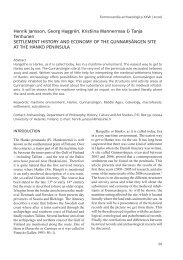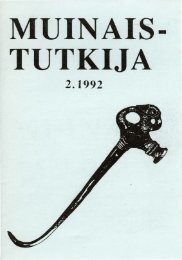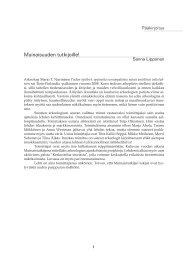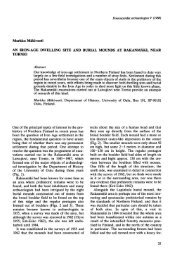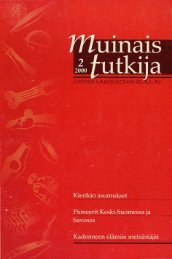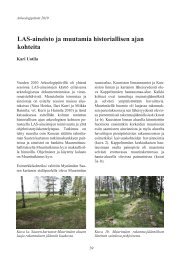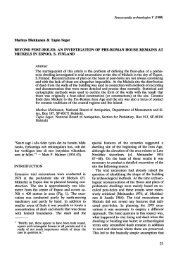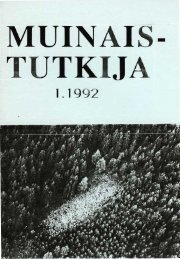THE MIKKELI TUUKKALA CEMETERY â THE 2009 EXCAVATIONS ...
THE MIKKELI TUUKKALA CEMETERY â THE 2009 EXCAVATIONS ...
THE MIKKELI TUUKKALA CEMETERY â THE 2009 EXCAVATIONS ...
Create successful ePaper yourself
Turn your PDF publications into a flip-book with our unique Google optimized e-Paper software.
Fennoscandia archaeologica XXVI (<strong>2009</strong>)Esa Mikkola<strong>THE</strong> <strong>MIKKELI</strong> <strong>TUUKKALA</strong> <strong>CEMETERY</strong>NEW INTERPRETATIONS– <strong>THE</strong> <strong>2009</strong> <strong>EXCAVATIONS</strong> ANDEsa Mikkola, National Bord of Antiquities, PL 913, 00101 Helsinki, E-mail: esa.mikkola@nba.fiIn autumn <strong>2009</strong>, seven inhumation graves andone cremation burial were found at Tuukkala inMikkeli in eastern Finland (Fig. 1). The graveswere found in an area, which was supposedto have been entirely excavated in 1886. Theoriginal purpose of the <strong>2009</strong> excavations,caused by a district heating pipe line project,was therefore only to check – just in case – thepreviously excavated areas and to collect thepossible stray finds left behind or lost in earlierinvestigations.The Tuukkala site is situated on a sand terraceca. 5.5 km south from the Mikkeli town centre.The buildings of a former garrison occupythe western edge of a sand terrace, located ca.92–94 metres above sea level. There is a smalllake behind the buildings at the western edge ofthe terrace, which slopes towards the south andsouthwest. In the east the terrace is bordered bya hill. At present, the Lake Saimaa is located ca.900 metres east from the site.RESEARCH HISTORYThe Tuukkala inhumation cemetery was found inJuly 1886, when the soldiers of the 22 nd ReserveCompany started to level down a sand moundin the western part of the exercise field adjacentto the garrison. The oval shaped mound wasca. 32 metres long (N–S) and 30.5 metres wide(W-E). Its maximum height was ca. 1 metre(Aspelin 1886, Heikel 1889: 182). The top of themound had already been levelled before 1886,as it featured a shallow depression, less than 10metres in diameter (Tuderus 1886a).The soldiers continued the levelling of thesouthern part of the mound for three days beforethe work was interrupted by the Companycommander Maj. Victor Tuderus, who later wrotea short account on the finding of the cemetery(Tuderus 1886a, cf. Paasonen 1886). There areseveral invaluable observations included in theaccount. Major Tuderus wrote that bones werefound just after an hour’s work on Saturday, July10, 1886. After he had identified them as humanbones, the skeletons were carefully unearthedwith shovels and finally by hand. However, nodocumentation was considered necessary andthe finds from the different graves were notkept separate. The majority of the artefacts werefound on Monday, July 12, 1886. The numberof finds decreased considerably on Tuesday, July13th 1886, when the work was also halted. Mostof the skeletons had been found at the southernedge of the mound with their feet facing the southor southeast, whereas the feet of the skeletonsfound closer to centre of the mound were facingthe east. Most often the burnt bones were foundnear the soil surface (Tuderus 1886a). The exactnumber of the graves then destroyed is notknown, but 20–30 is a credible estimate (see alsoTable 1). According to the Field Sergeant, whowas possibly supervising the levelling in person,a total of 26 graves were found in those threedays. According to the Sergeant Major, however,the graves were even more numerous. Later on,Pirkko-Liisa Lehtosalo-Hilander (1988: 193)has concluded on the basis of the find material(see below) that at least 7–8 female burials and4 male burials were destroyed during this firstphase of investigation.The State Archaeologist, professor J.R.Aspelin, arrived to Tuukkala and a large part ofthe mound was excavated under his supervision177
Fig. 1. The Mikkeli Tuukkala site with the <strong>2009</strong> excavation area and trial trenches (graves H4 andH9 not marked on the map), and all the documented graves. Drawing Hanna Kelola/National Boardof Antiquities.between July 21, and August 1, in 1886. Asprofessor Aspelin was the only archaeologistat the site, the drawings of the graves weredone by Major Tuderus and only the richestgraves were documented in detail. The speed ofinvestigation was indeed staggering: 32 graves– 24 inhumations, 6 cremations and 2 so-calledbone heap graves (Heikel 1889, on conflictingterminology see Purhonen 1997: 129–30;Taavitsainen et al. <strong>2009</strong>) – were excavatedin less than 10 days. These 32 graves, threeof which have been described as ”with burntbones” (Aspelin 1886), are also marked in thegeneral map drawn in August 1886. However,the “grave” 33 seen in Heikel’s publication(1899) is actually a collection of stray finds fromthe mound (Aspelin 1886). There is also someconfusion between the numbers in the map andthe ones in the find catalogue.After professor Aspelin’s departure thelevelling continued. This time nine inhumationgraves were found, and Major Tuderusalone was responsible for the archaeologicaldocumentation. One cremation burial was alsofound, but it is only mentioned in a letter toAspelin. Major Tuderus did not send the burnedbones to the National Museum because “thegrave did not contain any artefacts” (Tuderus1886b). The general map shows the relativepositions of the inhumation graves, but the onlypoint of reference in the map is the road leadingto Mikkeli (Tuderus 1886c; Heikel 1886: 216).However, as Major Tuderus wrote in his letterthat “despite excavating the grave mound inall directions, only nine graves were found”(Tuderus 1886c), the graves 34–42 must havebeen found at the western part of the mound.A tentative combination of the maps drawnin 1886 is included in the Fig. 1, while therather impressive find material pertaining tothe same year comprises: 8 axes, 31 knives, 16arrowheads, 16 fire steels, 33 pieces of flint, 9178
pieces of quartz, 4 pieces of whetstone, 2 irontools, 26 rings (10 iron, 16 silver/bronze), 1 strapdivider, 8 ring brooches, 7 belts with buckles,4 nails, 5 spinning whorls, 4 neck-bands withsilver mounting, 6 round silver brooches, 44oval tortoise brooches, 63 beads (44 bronze), 27bronze tubes, 40 chain holders, several pieces ofchain, 3 ear spoons, 2 animal-shaped pendants,11 penannular brooches, 2 pieces of silver, 2silver finger rings, 4 apron hems and severalpieces of clothing, leather and some pieces ofwooden coffins (Heikel 1889: 183–93).In October 1933, when the levelling of theexercise field was once again undertaken, threeor five unfurnished inhumation graves wereexcavated by Sakari Pälsi. These graves werefound south of the excavation area of 1886 (Pälsi1933). Later on that month, four or five furnishedgraves were found, and these were excavatedand documented by Lieutenant Nordenstreng.Their exact location is not known, but theyare reported to have been found next to “thesouthern edge of the previous find place”. Thus,the most probable location for these graves isthe area under the present gravel road calledSurnuintie. In May 1934 Sakari Pälsi excavatedyet again at Tuukkala, but he found only “a fewskeletons, whose scatteredness proves them tooriginate from the graves investigated in 1886”(Pälsi 1935). In October 1934, as the soldierscontinued the levelling work, a rich femaleburial was found and completely destroyedbefore the work was interrupted. Pälsi arrived atthe site and found four more inhumation burials,which were scantily furnished. Only some ofthese burials were been mapped, but neither theextent of the area then levelled nor the locationof the find places where scattered bones hadbeen found were marked down. Yet another twoinhumation graves were found in 1938, when thefoundations for the Tuukkala monument, weredug (Lehtosalo-Hilander 1988: 193).<strong>THE</strong> GRAVES OF <strong>2009</strong>The graves were found in an area of ca. 60 sq.metres (Figs. 1–2), and three of them weresituated directly on the pipe line. All the graveswere rather shallow. For example, the find layerof the grave 5 (H5) was encountered only 15cm below the present day ground surface. Thisis explained by the continuous levelling of theexercise field. The exact location of levelled areasis not known, nor do we know which areas havesurvived undisturbed and may still contain graves.It has also been rather difficult to determine theexact location of these graves vis-à-vis the earlierones due to limitations in the documentation ofexcavations pertaining to 1886 and to the 1930’s.Nearly all the graves found in <strong>2009</strong> had beenmore or less damaged. In all likelihood, these arethe graves that escaped destruction on July 13, in1886. Thereafter, the excavation seems to havecontinued under Aspelin’s command in the intactpart of the mound.The following descriptions are based on theobservations and notes made at the field. The materialhas not been organised or analysed – osteologicalanalysis is due in January 2010. Therefore, theinterpretations to be presented are only tentative.Grave 1 (H1), found in the original trialtrench, was ca. 150 cm long and ca. 50 cm wide.The longitudinal axis of it ran from southwestto northeast (238°) and the skull, had there beenTable 1. A summary of the excavations carried out at the Mikkeli Tuukkala site.Time Graves 1) Person responsible1886 – July 20–30 (>3) Major Tuderus1886 – July/August 32 (6) Aspelin1886 – August/September 10 (1) Tuderus1933 – October 3 or 5 Pälsi1933 – October 4 or 5 Lieutenant Nordenstreng1934 – May ? 2) Pälsi1934 – October 1 Nordenstreng/Varesmaa1934 – October 4 Pälsi1938 2 Sergeant Varesmaa<strong>2009</strong> – September/October 8 or 10 (1) MikkolaTotal >93 (11)1) The number of cremation burials given in brackets. 2) Few scattered skeletons.179
one, would have faced southwest. The graveseemed to be more or less intact, but severalsmall shovel pits were detected on its surface.The skeleton was quite well preserved but themissing skull. As the grave pit seemed to endabruptly at the cervical spine, the deceased seemsto have been buried decapitated, although thishas to be confirmed by forthcoming analyses.The grave furnishings were modest and includeda fire steel, three pieces of dark grey flint, twoiron rings and a small broken bronze belt bucklefound at the waist of the skeleton. The finds,which indicate that this was a male burial, werecovered by a thin layer of wood or bark.Grave 2 (H2) was found adjacent to grave 1 onits southern side. The grave was badly damagedand only the lower legs were encountered intactin the grave. The length of the preserved part ofthe grave pit was ca. 120 cm and the width ca.90 cm. The deceased had been buried in a coffinwith the head in the east and feet in the west. Alarge iron knife was found in the grave placedinside the right thigh and its tip turned towardsthe genitals. I assume that this was a male burial,which had been almost entirely destroyed onTuesday, July 13, 1886.Grave 3 (H3) was found adjacent to grave1 on its northern side. The grave contained adouble burial: an unfurnished inhumation andan unfurnished cremation (viz. grave 10 [H10]).The size of the grave pit was 225 x 75 cm andthe deceased had been buried in a wooden coffinwith the head towards the west (257°). Thesize of the coffin was 190 x 60 cm. The ribs,lower arms and the spine had almost entirelydecomposed, but the skull, upper arms and thelegs had been preserved rather well. The rightfoot was however missing and the bones of thelegs showed some traces of later damage.Grave 4 (H4) was found quite near to thesurface on the western side of graves 1 and 2.The rectangular feature measured ca. 200 x 80cm with its longitudinal axis oriented from northto south. No bones or artefacts were found in thefeature, which was full of small pits filled withdark mould. These indicate that the grave hadbeen totally destroyed by shovelling. Accordingto Major Tuderus (1886a), most graves on theFig. 2. Graves H8, H7, H2, H1, H3 and H9 seen form east. Photo Esa Mikkola/National Board ofAntiquities.180
Fig. 3. Bronze studded leather belt in the graveH7. Photo Esa Mikkola/National Board ofAntiquities.southern edge of the mound were N-S -oriented(Tuderus 1886a), and this feature may well beone of those graves.Grave 5 (H5) was located on the westernside of the grave 4. The longitudinal axis of theca. 170 cm long and ca. 50 cm wide grave ranfrom E to W (268°) with the head in the west.The south-eastern part of the grave had beenbadly damaged. While upper legs and arms hadbeen preserved, the upper part of the skull hadbeen smashed into pieces with a shovel. An ovalfire steel, a piece of grey flint, two bronze ringsand a belt buckle were found at the waist of theskeleton. These artefacts indicate that this wasyet another male burial.The identification of the feature H6, situatedbetween the graves 2 and 7, as a grave is nolonger valid. This pit-like feature containedseveral finds, such as pieces of a leather belt withbronze fittings, a belt buckle, and a ring broochof bronze. Also, a few small pieces of a silver (?)pendant were found in the feature. The finds maywell be originally from the grave 2.Grave 7 (H7) was found on the eastern sideof grave 2. Excluding the feature H6 that cutits north-western part, the grave was otherwiseintact. The longitudinal axis of the grave pit,which was ca. 160 cm long and ca. 60 cm wide,ran from E to W (261°) with the head in the west.The deceased had been buried in a coffin, whichmeasured 114 x 40 cm. Of the bones, only theskull had been preserved. The mandible was ofespecial interest: the permanent teeth, which hadnot yet been erupted, were visible under the setof deciduous teeth. The child in the grave musthave been only 6–7 years old at the time of death.Nevertheless, the grave was richly furnished asit contained three small silver artefacts, a smallpiece of hack silver, two knives, a whole and afragmentary fire steel, two palmette pendants,tiny fragments of bronze chain rings, a leatherbelt ornamented with a row of semicircularbronze studs (Fig. 3), an unidentified ironobject, a piece of a whetstone, a piece of flintand a small pebble of black-and-white granite.The pebble had been placed on top ofthe child’s right shoulder and the whetstonefragment between the legs. Both knives were onthe right hand side: one placed next to the feet,but the other nearer to the waist with a fire steelplaced next to it. The fragmented fire steel, onthe other hand, was found together with a pieceof flint in the south-western corner of the grave.The palmette pendants were both found betweenthe legs. Normally palmette pendants hang fromcruciform band-plaited chain holders, which areoften considered as Eastern Finnish or Savo-Karelian feature (Lehtosalo 1966: 82; Uino1997: 167). The pendants belong to the sametype as the pendants found in grave 37 in 1886(Heikel 1889: Fig. 65). No exact parallel for thebelt has been found. A silver temple ring or earring consisting of a plain round ring and a silverbead, and two small silver objects were foundnext to the child’s left ear (Fig. 4). Exact parallelsfor these objects are also unknown. Furthermore,a small piece of hack silver, possibly cut froma round silver brooch, was found in the child’sleft eye socket. It is worth remembering that ingrave 3 of the Mikkeli Visulahti, an inhumationcemetery located a few kilometres northeast ofTuukkala, a silver bracteate (KM 13441: 17) wasFig. 4. Silver objects found adjacent to a child’sskull in the grave H7. Photo Esa Mikkola/National Board of Antiquities.181
found in the mouth of the deceased (Lehtosalo1966: 13). However, the deliberate placement ofsilver inside the cavities of the human skull wasnot a common practice during the Late Iron Ageor Early Medieval Period in Finland.Grave 8 (H8) was situated adjacent to thegrave 7 on its southern side. The grave hadbeen partially damaged in its eastern part by thedigging of a large round pit. There were veryfew traces of a grave pit and the deceased hadalmost entirely decayed save the bones of thelower legs. The remains of the deceased had beenplaced from E to W with the head in the west.A bronze belt buckle and a bronze ring brooch(or another belt buckle of the type Kivikoski1973: Abb. 1195, Tafel 137) were found amongthe decayed organic mass. The deceased hadlikely been covered with birch bark. The gravewas only ca. 120 cm long, which could indicateanother child burial.Grave 9 (H9) has been interpreted as apreviously destroyed grave. Some remains ofwood and few bones were detected in a featureFig. 5. Double burial with inhumation H3and cremation H10 seen from east. Photo EsaMikkola/National Board of Antiquities.located in the north-eastern part of the excavationarea. Had it originally been a grave, it wouldhave been E-W -oriented like the majority of thegraves found in <strong>2009</strong>.Grave 10 (H10) is a cremation burial withinthe grave pit of the inhumation grave H3 that wasobservable as two larger concentrations of burntbone between the legs of the deceased (Fig. 5),while the third and smallest concentration hadbeen placed outside the body adjacent to theright knee. At this stage of the research it isimpossible to say whether these concentrationsrepresent individual burials or whether they areall from one individual. A round heap of ratherlarge white, grey or soot black bones had beenplaced between the feet. The missing right footof the inhumation was found in the heap of burntbones. This indicates that the cremated boneswere dug into the inhumation grave when theskin, flesh, cartilages or joints still were keepingthe bones of the foot together. Another heap ofbones, more or less rectangular in shape, hadbeen place between the upper legs and it coveredthe right leg. The bones outside the skeletonwere fewer but rather large. All the burnt boneswere found inside the rim of the wooden coffin.Interestingly, two pieces of burnt bone had beenplaced next to the hips and two on top of thelower arms. The cremation (or cremations) andthe inhumation were both unfurnished.Grave 11 (H11) was found in the easternpart of the excavation area next to the abovementioned round pit and a presumably modernpost-hole. The digging of the post-hole haddestroyed most of the skull and only the lowermandible had survived. The grave pit, whichwas 160 x 60 cm in size, was E-W -oriented(262°) with the head in the west. Two ovaltortoise brooches, two chain holders, a bronzebead and three bronze bar-shaped chain-links,a bronze ring brooch and an iron knife werefound in the grave. The brooches are of theAilio H-type (e.g., Uino 1997: 355–6) and thechain holders belong to cruciform band-plaitedvariant (e.g., Heikel 1889: Fig. 64). However,no pendants were found in these chain holders.Almost all bronze artefacts were covered by alayer of wood (Fig. 6), some plant remains andhair (from fur?). With all likelihood, some textilefragments have survived adjacent to the bronzebrooches, but there were no traces of a bronze182
spiral ornamented apron. The bronze jewelleryidentifies the find as a female burial, possiblythat of a young girl.DISCUSSIONThe exact number of graves found in Tuukkalais not known due to insufficient and sometimesinaccurate documentation and careless excavations,but 90–100 is a credible estimate.Eleven of these are cremation burials, others areinhumation burials. The actual number of burials,however, may be considerably higher. Intactgraves can possibly still be found in certain areas,especially in the vicinity of the <strong>2009</strong> excavationarea and around the Tuukkala monument.All but one inhumation burial (6/7) found in<strong>2009</strong> seems to belong to males on the basis of thegrave goods or skeletal features. Both children’sburials have been listed here as male, since inboth cases the deceased was buried with a leatherbelt, which is typical for male burials in Tuukkala(Heikel 1889). Only one of the graves belongs to afemale. These gender identifications will hopefullybe confirmed in the forthcoming DNA analysis– suitable samples have been obtained from thegraves H1, H3, H5, H7 and H11.An idea about the presence of a churchon the grave mound in Tuukkala has been putforward by Paula Purhonen (1997: 125). Theidentification of the church is mainly based onexistence of a rectangular area void of graves inAspelin’s general map (Purhonen 1997: 126, Fig.136, passim). No building remains were foundin the 1886 excavations, but, on the other hand,the identification of the decomposed remainsof a wooden building would have been ratherdifficult considering the excavation methodsand the speed of investigation. Two post-holeslocated in the eastern part of the excavationarea were the only building remains found in<strong>2009</strong>, and stratigraphically they were among theyoungest features at the site.According to Major Tuderus, the top ofthe one-metre-high mound had already beencleared from grass and topsoil before the year1886 (Tuderus 1886a). This may offer a partialexplanation for the area void of graves in thegeneral map of 1886. Furthermore, by payingattention to details in Major Tuderus’s letter toprofessor J.R. Aspelin, the graves 34–42 (1886)Fig. 6. The bronze jewellery in the grave H11was covered by a layer of wood (a coffin lid?).Photo taken from east. Photo Esa Mikkola/National Board of Antiquities.can be positioned in relation to the graves 1–32(1886), and this further reduces the area that wasonce thought to be devoid of graves.Another argument in the identification of thechurch has been the orientation of the gravesaround the rectangular area (Purhonen 1997:128). However, Major Tuderus informs us that theorientation for most of the graves in the southernedge of the mound was either S-N or SE-NWwith the heads facing the north or north-west.Closer to the centre of the mound, the graveswere more or less E-W -oriented (see above). Onecannot escape the notion that at the edges of themound the graves were dug against the contourlines. Similar assumption regarding the influenceof the topography on the orientation of graveshas been put forward by Theodor Schwindtin 1893, however, based on only one examplefrom Sakkola (Uino 1997: 67 with references).Nevertheless, there are many similarities in thetopography of Karelian inhumation cemeteriesand Tuukkala (cf. Uino 1997: 55).The distribution of grave goods has alsobeen used as an argument when locating thepresumed church. While, graves containingswords and spearheads have not been found inTuukkala, nine axes are known. Four of them are183
from the northern part (graves 20, 31, 32 and 39;KM 2481:204, 258, 268 and 323 respectively),one (grave 34, KM 2481: 270, cf. Fig. 1) fromthe middle and three from the southern part ofthe grave mound (KM 2481:1, 2 and 3). Theninth axe (KM 9795:7, grave 2, exact locationunclear) was found at least some 20 metres southof the grave mound in 1933. Due to this ratherrandom distribution, the axe-graves cannot, inmy opinion, be used as evidence for the locationof a sacral building (cf. Purhonen 1997: 128–9).As mentioned above, three heaps of burntbone were found inside the grave H3. InTuukkala, the location of 6 cremation burials hasbeen marked on the general map of 1886 (4, 6,7, 8, 10 and 28). In addition, three cremationshad been destroyed before Aspelin’s arrivaland one was found but not documented afterhis departure from Tuukkala in 1886. Mostcremation burials were found near the groundsurface, and the only other one found in the sameplace as an inhumation burial, was located some50 cm above the skeleton (Heikel 1889: 211).Two of the cremation burials had been furnished:grave 4 contained only a knife, but a penannularbrooch, three oval tortoise brooches, pieces ofbronze and iron chain, three chain holders, twoknives and a fire steel (KM 2481:143–154) werefound in grave 7. The burial (H10) excavated in<strong>2009</strong> differs from other documented cremationburials in Tuukkala in many respects, but as nobones either from inhumation or cremation havebeen analysed or 14 C-dated, there is little pointto take the discussion of this potential doublegrave any further. In any case, the existenceof cremation burials in inhumation cemeterieshas been discussed in detail, for example, byTaavitsainen (1991), Lehtosalo-Hilander (1992),Uino (1997: 67–8), Purhonen (1997: 129–30) andmost recently by Taavitsainen, Hiekkanen andOinonen (Taavitsainen et al. <strong>2009</strong>). The questioncould be approached by abandoning the strictdichotomies, for example Christian vs. pagan, asmodern fallacies and by adopting more pluralisticor syncretistic viewpoint particularly regardingthe realm of burial customs and practices.The date of the Tuukkala cemetery has beendebated for long. While A.O. Heikel datedTuukkala to “the pagan era, the late Iron Age”(Heikel 1889: 182), Pirkko-Liisa Lehtosalo-Hilander (1988: 194) suggested a date fromthe 11 th to the early 13 th century on typologicalgrounds. Paula Purhonen (1997: 131, Fig. 141)dates the graves of Tuukkala from the lastquarter of the 11 th century to year 1300, mainlybased on the typological dating of the roundsilver brooches and the ring brooches. However,an ear of rye (KM 2481:288) found in 1886in the grave 36 has been radiocarbon dated bylater research (see Purhonen 1997: 247). Whencalibrated with an online version of OxCal 4.1(https://c14.arch.ox.ac.uk/oxcal/OxCal.html)the date Hela-109: 625 ± 65 BP falls with 68.2% (1 sigma) probability to cal. AD 1292–1328(27.2 %) or cal. AD 1340–1396 (41.0 %). Thegrave 36 belonged to a female and containedtwo oval tortoise brooches of Linturi C-type(Linturi 1980), a knife with a bronze sheath, twochain holders, a neckband with silver fittings,ear tubes, several pieces of clothing and otherorganic material (Heikel 1889: 217–9). It wouldnot come as a surprise if the future 14 C-datesproved that the Tuukkala cemetery was mainlyused during the 13 th and 14 th centuries withoccasional burials still made in the 15 th century.Finally, the excavation of <strong>2009</strong> demonstratedthe importance of double-checking all the areas,presumably fully excavated or otherwise entirelydestroyed, in connection with new buildingprojects, especially if the original investigation tookplace in the 19 th century. The shortcomings in theearlier documentation may result in surprises, and,just as in the present case, in the most interestingarchaeological finds of the recent years.REFERENCESUnpublished sourcesDepartment of Archaeology, National Boardof Antiquities, Helsinki.Aspelin, J.R. 1886. St. Michel Tuukkala. J.R. Aspelinsanteckningar vid utgrävningen i Juli 1886.Paasonen, J. 1886. A letter to professor Aspelin, July16, 1886. Arch. No. 83/1886Pälsi, S. 1933. Mikkeli Tuukkala. Excavation report.Pälsi, S. 1935. Mikkeli Tuukkala, löytöjä ja kaivauksia1934. Excavation report.Tuderus, V. 1886a. St. Michel: Tuukkala. Berättelse,Aug. 2, 1886. Arch. No. 88/1886.Tuderus, V. 1886b. “Högtärade Broder!”A letter to professorAspelin. Sept. 26, 1886. Arch. No. 155/1886.184
Tuderus, V. 1886c. Förteckning öfver skelett samtdiverse arkeologiska föremål funna å 22rareservkompaniets exercisplan under hösten 1886.Oct. 3, 1886.Department of Archaeology, University ofHelsinki, Helsinki.Lehtosalo, P.-L. 1966. Mikkelin kalmistot ja karjalainenkulttuuri. Unpublished MA thesis.LiteratureHeikel, A.O. 1889. Tuukkalan löytö. SuomenMuinaismuistoyhdistyksen Aikakauskirja X: 181–224. Suomen Muinaismuistoyhdistys, Helsinki.Kivikoski, E. 1973. Die Eisenzeit Finnlands. Bildwerkund Text. Neuausgabe. Finnische Altertumsgesellschaft,Helsinki.Lehtosalo-Hilander, P.-L. 1988. Esihistorian vuosituhannetSavon alueella. Savon historia I.Kustannuskiila Oy. Kuopio.Lehtosalo-Hilander, P.-L. 1992. Pogrebenija poobrjady ingumacii v Finljandii. Drevnosti slavjani finno-ugrob. Sankt-Peterburg.Linturi, E. 1980. Ristiretkiajan soikeat eläinkoristeisetkupurasoljet. Helsingin yliopistonarkeologian laitos. Moniste n:o 24. Helsinginyliopisto, Helsinki.Purhonen, P. 1997 Kristinuskon saapumisestaSuomeen: uskontoarkeologinen tutkimus. SuomenMuinaismuistoyhdistyksen Aikakauskirja 106.Suomen Muinaismuisto-yhdistys, Helsinki.Taavitsainen, J.-P. 1991. Cemeteries or refuseheaps? Archaeological formation processes and theinterpretation of sites and antiquities. Suomen Museo1991: 5–14.Taavitsainen, J.-P., Hiekkanen, M. & Oinonen,M. <strong>2009</strong>. Keminmaan Valmarinniemenpolttohautaukset. In J. Ikäheimo & S. Lipponen(eds.), Ei kiveäkään kääntämättä. JuhlakirjaPentti Koivuselle: 203-212. Pentti Koivusenjuhlakirjatoimikunta, Oulu.Uino, P. 1997. Ancient Karelia: ArchaeologicalStudies. Suomen MuinaismuistoyhdistyksenAikakauskirja 104. Suomen Muinaismuistoyhdistys,Helsinki.185



